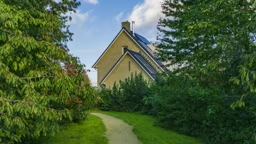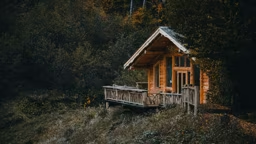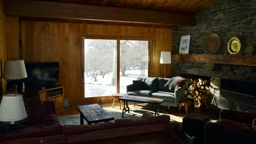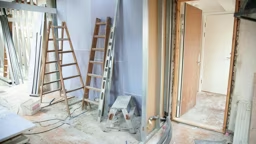You love your cabin, so why not spend some time there in the off-season? For many cabin owners, the answer is that the getaway spends part of the year buried under a snowbank with no running water.
If you can relate and are wondering what it would take to transform your cabin into the type of place you could visit all the time, we have corralled a few factors to consider. Here’s what to know.
What Is a Seasonal Cabin?
First, let’s define what is described as a “three season” cabin. This generally refers to a structure that’s not livable in the winter for a variety of reasons. These seasonal homes might lack central heating or a water source that’s protected from freezing temps. Even if you could heat the place enough to enjoy it during winter weekends, you might have to drain all the water lines every time you leave.
A three-season cabin may not have insulation in the walls or roof, or, if it does, it may not be up to code. The structure’s foundation matters too: It may have been built on an open foundation, piers or an uninsulated concrete slab.
Finally, look into how your local municipality classifies residences. A cabin might be considered seasonal unless it has an approved wastewater (septic) system, a supply of drinkable water and access for fire safety. It could also need to meet other zoning or setback requirements.
Should You Convert?
If these factors apply to your cabin or cottage and you think that being a year-round getaway would increase your retreat’s value (and your quality of life), be sure you can actually get there in the winter. Is the road to the home plowed regularly? If you have a lakefront site that is very narrow, what would you do with snow plowed out of your driveway?
Additionally, if you can get there, consider how your time spent there would be different than in other seasons. Is the area around your cabin just a summer community that might lack amenities in the off-season, like restaurants, cultural events or neighbors? A winter weekend spent at a hotel near your cabin could help you decide the best course of action.
The Foundation
If you’re ready to convert a seasonal cabin, start from the bottom up by addressing the foundation. With an existing concrete slab, the only real way to help with insulation is to dig down around the perimeter of the cabin and add rigid insulation to help eliminate thermal bridging from the adjacent soils. If you have an existing crawlspace, you might be able to insulate under the cabin’s floors or add insulation to the side walls of the crawlspace. This might afford you the option of conditioning the crawlspace, which could provide a way to keep water lines warm.
Running Water
Speaking of water, you will need to protect water lines from the cold to keep them from freezing and flooding your interior. To do this, you’ll need to insulate and provide minimal heat to the cabin over the course of the winter to avoid freezing up the lines. If your existing cabin has plumbing in the exterior walls, that plumbing would probably need to be moved.
It’s also important to consider the depth and location of pipes and your septic system, says Mark Gordon of Rangeley Building & Remodeling in Rangeley, Maine. He suggests running pipes below the frost line. “It’s a good idea not to run snowmobiles on or pack down any septic locations,” he explains. “The frost will be driven down lower in the ground with traffic.”
Insulation Considerations
With most seasonal cabins, the insulation (or lack thereof) is a concern. Start by asking a professional to check the insulation in your cabin’s attic and walls. “Many times, cabins are built with 2-by-4 construction, and you can only get so much insulation in those walls,” reports Brent Gunsbury of Bercher Design & Construction in Baxter, Minnesota. Conventional construction methods for year-round homes in his area often use 2-by-6 framing to allow for deeper insulation and to meet building codes for R-value. So, depending on your cabin’s construction, converting it could mean addressing those smaller wall studs.
You also should look for gaps around openings like doors and windows and consider adding weatherstripping. Thermal-backed draperies or window quilts also can help block drafts. For most cabins, replacing single-pane windows with insulated units is a worthwhile investment, says Matt Balmer, co-founder of Land’s End Development in Crosslake, Minnesota.
Heating and Utilities
Seasonal cabins often have fireplaces or woodstoves and no other sources of heat. While heating with wood is possible in the winter, it’s labor-intensive and only works when someone is in the cabin to feed the fire. A few common options for year-round heat systems that don’t require running ducts throughout the house are propane wall furnaces, electric heaters, baseboard units and pellet stoves. “Usually propane decorative stoves or Rinnai propane heaters work well,” Mark says. “They’re inexpensive to install and pretty low maintenance.”
Your cabin’s access to utilities can affect the type of heating system you choose as well. Is electricity available? Is it reliable enough to prevent pipes from freezing? If you choose propane heat, can your site be accessed in the winter to re-fill a propane tank? Pellet stoves can operate on a thermostat but need consistent electrical service in order to do so.
Finally, consider using a web-enabled thermostat so you can heat the place up before you arrive for the weekend. This smart home technology also can alert you if the temperature inside dips too low.
Give these factors proper consideration and in time, you may find winter looks a little different from the cabin.
Should It Stay or Should It Go?
When is it better to just take a seasonal cabin down and start over? “That’s a delicate conversation we tend to have with clients,” says Brent. “It becomes a bigger life discussion.” He asks clients to look into the future, if possible, to really consider what kind of cabin will best suit their needs for the long term.
“The problem with some older cabins is the fact that once you start trying to remodel or add on to them, it can start a domino effect with repairs and updates,” says Tony Stoll, an architect and partner with BHH Partners in Perham, Minnesota. “Sometimes existing portions of a cabin limit the options that the owner might have for remodeling.
“Each situation is unique and really depends on several factors, such as project budget, proposed updates and the condition of the existing cabin,” Tony says. Will retro-fitting systems and adding insulation be effective in making a cabin livable? Brent questions the wisdom of investing in a cabin that might have to be stripped down to the studs and have a replacement concrete slab poured.
Local regulations may determine your next move. If you have to remodel an existing structure to maintain a prime location at the edge of a lake (when local restrictions would require a new building to be set much farther back), remodeling could be the best option.



_11868_2023-11-09_10-09-1280x720.avif)
_11868_2023-11-09_10-09-1280x720.avif)
_11868_2023-11-09_10-09-1280x720.avif)
_11868_2023-11-09_10-09-1280x720.avif)
_11868_2023-11-09_10-09-1280x720.avif)







